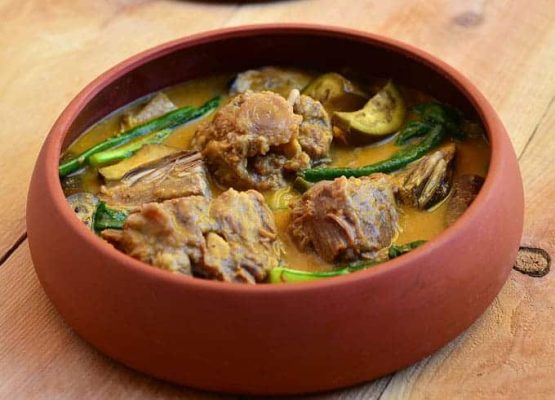Kare-Kare is a traditional Filipino stew widely recognized as one of the country’s national dishes. It is a savory and flavorful dish made with oxtail, tripe, and vegetables such as eggplant, string beans, and banana heart, all cooked in a rich peanut sauce. Kare-Kare is usually served with bagoong (fermented shrimp paste) and hot rice.
Kare-Kare’s origins can be traced back to the Philippines’ Spanish colonial period, during which the Spanish cocido and the Indian curry likely influenced the dish. Over time, Kare-Kare has evolved into the distinct dish it is today, with each region of the Philippines adding its unique spin to the recipe. Today, Kare-Kare is a staple in Filipino cuisine, often served at family gatherings, special occasions, and fiestas.
Kare-Kare’s Global Popularity
Kare-Kare’s popularity has steadily increased in recent years, with the dish gaining a following beyond the Philippines. One reason is the growing interest in international cuisine, with more people seeking authentic dishes from different cultures.
Filipino restaurants around the world have started to feature Kare-Kare on their menus, making it more accessible to people who are interested in trying out Filipino cuisine. For example, popular Filipino restaurant chains like Jollibee and Max’s Restaurant in the United States serve Kare-Kare. Filipino restaurants in countries like the United Kingdom, Spain, and Germany offer Kare-Kare in Europe.
Social media has also played a significant role in the spread of Kare-Kare’s popularity. Food bloggers and influencers have shared their experiences of trying Kare-Kare, often accompanied by mouth-watering photos that showcase the dish’s rich colors and textures. This has helped to generate buzz around Kare-Kare and has led to more people becoming curious about the dish.
Furthermore, Kare-Kare’s popularity has also been boosted by its inclusion in various food and travel programs. Many television shows and YouTube channels have featured the dish, showcasing its unique flavors and history to worldwide audiences. The combination of social media, the rise of international cuisine, and media exposure have contributed to Kare-Kare’s growing popularity in the global culinary scene.
Adaptations and Variations of Kare-Kare
Kare-Kare is a versatile dish that can be adapted to suit different palates and dietary needs. While the traditional version of Kare-Kare is made with beef or oxtail, it can also be prepared using other types of meat or even vegetables. Here are some examples of Kare-Kare adaptations and variations:
- Vegetarian Kare-Kare – Instead of using meat, this version of Kare-Kare uses tofu or a variety of vegetables like eggplant, bok choy, and green beans. It still features the traditional peanut sauce (some use all-natural peanut butter powders) and is served with rice and fermented shrimp paste.
- Seafood Kare-Kare – This version of Kare-Kare uses seafood like shrimp, squid, or fish instead of beef or oxtail. The peanut sauce is still used but has a lighter consistency to complement the seafood’s delicate flavor.
- Chicken Kare-Kare – This version of Kare-Kare uses chicken instead of beef or oxtail. The chicken is usually cooked with the bones to give the dish more flavor, and the peanut sauce is still used but with a milder taste than the beef version.
- Pork Kare-Kare – This version of Kare-Kare uses pork hocks or pork belly instead of beef or oxtail. The pork is slow-cooked to make it tender, and the peanut sauce is still used, but with a slightly different flavor to complement the pork’s taste.
While these adaptations of Kare-Kare are delicious in their own right, they differ from the traditional version in terms of taste and texture. Using different meats and vegetables changes the flavor profile of the dish, and the consistency of the peanut sauce may also vary. Nonetheless, these adaptations and variations are a testament to the versatility and adaptability of Kare-Kare, making it a dish that people with different tastes and dietary requirements can enjoy.

Kare-Kare in the Culinary World
Kare-Kare has gained recognition as a globally-known Filipino dish and has been included in international culinary events and competitions. For instance, the World Street Food Congress in Singapore featured Kare-Kare in its lineup of dishes, and it has also been featured in Asia’s 50 Best Restaurants list.
The increasing popularity of Kare-Kare in the global culinary scene has helped put Filipino cuisine on the map. It has helped highlight the unique flavors and ingredients commonly used in Filipino cooking. In addition, the popularity of Kare-Kare has led to more attention being given to other Filipino dishes, helping to showcase the rich diversity of Filipino cuisine to a broader audience.
Moreover, Kare-Kare’s popularity has also helped to promote the use of traditional Filipino ingredients in the global culinary scene. Using ingredients like annatto, peanut butter, and bagoong (shrimp paste) in Kare-Kare has helped showcase their versatility and unique flavors. This has helped to encourage more experimentation with Filipino ingredients and flavors in the culinary world.
Overall, the global recognition of Kare-Kare has significantly impacted Filipino cuisine’s representation in the international culinary scene. It has helped to increase awareness of Filipino cuisine’s unique flavors, ingredients, and cooking techniques. It has increased opportunities for Filipino chefs and restaurants to showcase their culinary skills and creations to a wider audience.
Conclusion
In conclusion, Kare-Kare has risen to global fame and become a significant culinary dish. It is a testament to the versatility and adaptability of Filipino cuisine, and its increasing popularity has helped to put Filipino cuisine on the map. Kare-Kare’s recognition in international culinary events and competitions has helped to showcase Filipino cuisine’s unique flavors and ingredients. It has encouraged more experimentation with Filipino flavors in the global culinary scene. Its popularity has also helped to promote the use of traditional Filipino ingredients. It has increased opportunities for Filipino chefs and restaurants to showcase their culinary skills and creations. Kare-Kare’s rise to global fame signifies the growing interest and appreciation for diverse cuisines and their unique flavors.

